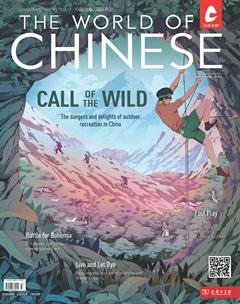Singing the Changes

When youre adopting a folk tale thats been around for 1,000 years, what can you do thats new?
Thats the question for director Zhang Xianfeng, whose latest film The Legend of the White Snake: Love opened in China on May 20. It strives for novelty in a household legend that has been retold in countless forms over the centuries, from operas and plays, to TV dramas, movies, feminist novels, and comics books. But Zhang looks to an ancient medium—Cantonese opera, or Yueju (粵剧).
Based on a seven-year-old work of the Guangdong Cantonese opera troupe, the film version of The Legend of the White Snake: Love is co-produced by Zhujiang Film Group and the troupe, in efforts to broaden the operas audiences. Despite high online ratings, it only generated 20 million RMB in ticket sales by the end of June. The high-pitched singing, exaggerated movements, and Cantonese narrations, which all come from its original Cantonese opera version make, it daunting for some viewers.
Yet mixing opera with cinema seems to have clicked with the younger generation, sparking discussion about Chinese opera on social media platforms. The films trailer garnered nearly 3 million views on Bilibili, Gen Zs favorite video site. The rousing success of the movie could breathe new life into Chinese opera, which has long been on its way out of the modern media landscapes center-stage due to a fading fan base.
The legend of the White Snake has been passed down orally since at least the Tang dynasty (618 – 907), with the best-known version first written in the Ming dynasty (1368 – 1644). It tells of two snake spirits—White Snake and Green Snake—who transform into a pair of young women to visit the human world. White Snake falls in love with a man named Xu Xian she meets on the banks of Hangzhous West Lake, and they marry. However, a fanatical monk named Fahai is determined to separate the lovers and banish the spirit, eventually imprisoning White Snake under the Leifeng Pagoda.
The tale has grown over the years to become one of Chinas most popular love stories. Various adaptations have tried to infuse the old tale with new meanings: from love that transcends traditional boundaries, to the snake spirits anti-authoritarian or feminist ethos as they battle Fahai to free Xu Xian. Zhangs 101-minute Yueju movie stays largely faithful to the original tale and preserves an older ending that more modern adaptions do away with.
Zeng Xiaomin, 43, a lead performer of the Guangdong Cantonese opera troupe, reprises her role of White Snake for the film. Other performers from the troupe, including Wen Ruqing (Xu Xian), Zhu Hongxing (Green Snake) and Wang Yanfei (Fahai) also show up in the film.
As part of efforts to broaden the appeal of this opera, the stage version of White Snake: Love dragged the tale into the 21st century, incorporating digital scenic and lighting design, conveyed via digital screens.
But the movie takes it one step further. Director Zhang chooses to blend sophisticated visual effects into Cantonese opera. Every frame is like an ink wash painting, with CGI of misty rain, cloudy skies, falling flower petals, and distant mountains, mixed up seamlessly with real actors. Zhang fuses virtual symbols like lotus flowers, plum blossom, bamboo forests, and arched bridges into scenes shot from reality to deliver Eastern aesthetics, of which the core is xieyi (寫意), or an impressionistic style.
In the climactic scene, where White Snake battles Fahai to rescue Xu, she summons the power of air and water to flood the temple. While stage opera performers usually perform this with a mere twirling of the long shuixiu (水袖)—literally “water sleeves”—of their floor-length costumes, the movie presents a spectacular white-and-black, water-and-fire battle between White Snake and Fahai, aided by a suspenseful soundtrack. The monstrous waves rush violently at Fahai, but are repulsed by roaring flames.
The film builds on the millennium-old tropes of Cantonese opera, which was added to UNESCOs List of Intangible Cultural Heritage in 2009. Similar to other local operas, performers use the techniques of chang, zuo, nian, and da (singing, body movements and hand gestures, rhythmic spoken narrations, and acrobatic fights respectively) to tell a story.
The culture has experienced ups and downs. It played an important role in Cantonese cultural life, but was interrupted by World War II and later the Cultural Revolution. From 1966 to 1976, only eight “model operas” based on Peking opera and Western ballet were allowed to be performed. By the time the ban was lifted, many Yueju performers had already quit the profession.
In an interview, Zhang said that while watching a performance in a theater in Guangzhou, he found everyone sitting around him was gray-haired. “If I only make movies for the elderly, who will pass on this culture?” he said. The Legend of the White Snake: Love is a good start, but the underlying problem of the profession has yet to be addressed—a lack of young talents.
– Wency Chen
 汉语世界(The World of Chinese)2021年4期
汉语世界(The World of Chinese)2021年4期
- 汉语世界(The World of Chinese)的其它文章
- Exploding Bikes
- All the Fish in the Sea
- Flying Forward
- 库克岩石
- Live and Let Dye
- Call of the Wild
